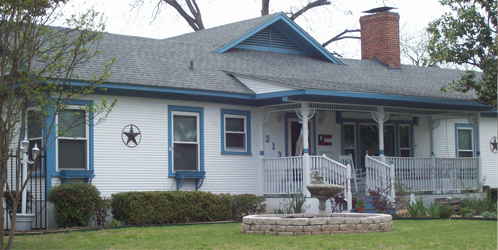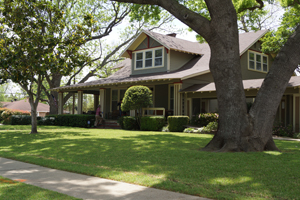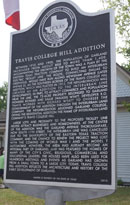Garland’s Travis College Hill Addition was lauded as the first Garland area on track to be listed on the prestigious National Register of Historic Places as downtown Garland endeavors to become the second local district to be so recognized.
“This would be the second for Garland within one year. That’s pretty good,” said renowned preservation architect Nancy McCoy in discussing the city’s proposed nomination before Garland City Council last night.
McCoy is with Quimby McCoy Preservation Architecture, the Dallas firm that the city hired to conduct the downtown Garland survey of historic properties in preparation for the nomination. In its work session last night the city was asked to consider a resolution in support of the downtown Garland commercial district nomination. Some council members asked for clarification of certain matters before moving forward with the request. The nomination is slated to be acted on at the Texas Historical Commission’s State Board of Review in Houston on January 21.
A public hearing on the downtown nomination will be held at 5:30 p.m. tonight in the Goldie Locke Room of the city’s Duckworth Building downtown. Members of the Texas Historical Commission will be present to answer questions.
In a meeting in Alpine in September, the state review board agreed to advance the Travis College Hill residential district nomination to the National Parks Service for final approval. The two-block neighborhood, between Avenues B and D with 11th Street at its heart, was platted in 1913,
McCoy told council members that the downtown Garland area is an ideal candidate for the national recognition because “the beginnings of Garland area on display” in this area. The area includes a variety of buildings ranging from the West Side’s early masonry structures that survived the 1899 fire to the more modern style of the former Lone Star Gas Company building from 1956 on State Street. A total of 52 commercial buildings downtown area have been deemed “contributing” to the proposed nomination, McCoy said.
Boundaries of the district are Avenue A to the south, Glenbrook to the west, just beyond the Santa Fe tracks on the east, and just behind the State Street-facing buildings of the downto wn Square on the north.
wn Square on the north.
“The principal impact (of a district’s being on the National Register) is heritage tourism,” McCoy noted. A person that comes to an area for heritage tourism typically “spends more than an average tourist” in an area.
The honorary recognition “doesn’t come with a lot of strings,” she told council. “It encourages preservation but doesn’t require it.” It doesn’t attempt to manage or impact disposition of property, nor does it require public access to private property, she stated.
Economic incentives that accompany the recognition are a major benefit to a district’s being added to the National Register, McCoy explained.
Property owners of income-producing property in a historic district are eligible for an investment tax credit amounting to 20 percent on federal income taxes as well as a 25 percent state tax credit on rehabilitation costs, amounting to 45 percent, said McCoy. After her presentation she added that the State of Texas also allows sales-tax exemption for products used in historical preservation restoration and Dallas County provides a “small” tax incentive as well.
Robert A. Smith, downtown property owner and chairman of the Historic District Advisory Committee, an ad hoc group of local individuals the city appointed to study the matter during 2016, said a downtown historic district typically promotes “pride and reinvestment among property owners.”
“It creates jobs, rebuilds community, attracts reinvestment, and makes good business sense,” he said.
He added that the tax credit represents a “tool for property owners to use” but not a mandate.
Council Member Rich Aubin expressed concern that the area included in the nomination includes the square’s east side (Crossman Block) while the city debates the future of the block. Aubin said he understood that the creation of a historic district doesn’t commit to preserving buildings in the district. He said he was concerned that it would be “disingenuous for us to move forward” with the nomination and then six months later demolish the Crossman block on the east side of the square or alter it to the point of its losing its historic character.
Council Member Lori Barnett Dodson asked whether the Crossman Block should be removed from the area to be acted on in the National Register nomination until council gives direction on the block’s future.
McCoy said the Crossman Block could not be removed from the proposal because the block, a portion of which dates to 1906, is considered “contributing” to the district because as it currently exists, qualifies within the period of significance, 1897-1967.
“It’s within its boundaries,” she said. “Because of the historical integrity of the building, it came out contributing.”
City Manager Bryan Bradford responded that the city would move forward with a proposal for the East Side in the first quarter of 2017.
Dodson asked whether all downtown property owners were involved in the entire process, from start to finish, and asked whether minutes had been kept of the ad hoc committee meetings. Besides Smith, ad hoc committee members were identified as Mike Hayslip of the Garland Landmark Society, Jack McDaniel of Roach Feed & Seed, Carlos Porras of Dos Banderas restaurant, Norm Bjornnes of Oaks Properties, Cleo Holden of Preservation Garland, architect Ron Hobbs with offices on the square, Tom Bailey with A&S Properties and John Baker of the city manager’s office. They represent current and former property owners and others with assorted ties to downtown.
Becky King, managing director for strategic initiatives for the city of Garland, stated that volunteers Louis Moore and Kay Moore of the Downtown Garland Business Association along with herself and Robert Smith personally had notified each of the downtown property owners of tonight’s meeting.


